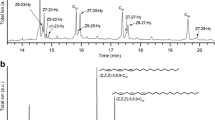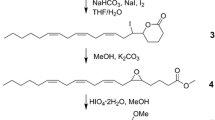Abstract
(Z)-7-Dodecenol failed to interrupt pheromone-mediated anemotactic responses by male cabbage looper moths,Trichoplusia ni (Hübner) (Lepidoptera: Noctuidae) in a wind tunnel when released 5 cm crosswind on both sides of the pheromone source or 10 cm upwind of the source to create an overlapping plume downwind. Significant inhibitory effects of (Z)-7-dodecenol were observed when released with the six-component pheromone blend from the same septum or abutting septa. These results indicate that (Z)-7-dodecenol needs to be received simultaneously with the pheromone blend to inhibit the anemotactic responses of males to the sex pheromone. We suggest that this feature and the filamentous nature of pheromone plumes render pheromone signals relatively protected from background chemical noise that may originate from pheromone plumes of other insect species. Unless filaments from a pheromone signal and an inhibitor arrive simultaneously, the integrity of the signal is maintained.
Similar content being viewed by others
References
Baker, T.C., andHaynes, K.F. 1989. Field and laboratory electroantennographic measurements of pheromone plume structure correlated with oriental fruit moth behaviour.Physiol. Entomol. 14:1–12.
Baker, T.C., Willis, M.A., Haynes, K.F., andPhelan, P.L. 1985. A pulsed cloud of sex pheromone elicits upwind flight in male moths.Physiol. Entomol. 10:257–265.
Berger, R.S. 1966. Isolation, identification and synthesis of the sex attractant of the cabbage looper.J. Econ. Entomol. 59:767–771.
Bjostad, L.B., Linn, C.E., Du, J.W., andRoelofs, W.L. 1984. Identification of new sex pheromone components inTrichoplusia ni, predicted from biosynthetic precursors.J. Chem. Ecol. 10:1309–1323.
Bossert, W.H., andWilson, E.O. 1963. The analysis of olfactory communication among animals.J. Theor. Biol. 5:443–469.
Daterman, G.E., Daves, G.D., Jr., andSmith, R.G. 1975. Comparison of sex pheromone versus an inhibitor for disruption of pheromone communication inRhyacionia buoliana.Environ. Entomol. 4:944–946.
Haynes, K.F., andHunt, R.E. 1990. Interpopulational variation in emitted pheromone blend of cabbage looper moth,Trichoplusia ni.J. Chem. Ecol. 16:509–519.
Hunt, R.E., Zhao, B.-G., andHaynes, K.F. 1990. Genetic aspects of interpopulational differences in pheromone blend of cabbage looper moth,Trichoplusia ni.J. Chem. Ecol. 16:2935–2946.
Kaissling, K.-E. 1986. Temporal characteristics of pheromone receptor cell responses in relation to orientation behaviour of moths, pp. 193–199,in T.L. Payne, M.C. Birch and C.E.J. Kennedy (eds.). Mechanisms in Insect Olfaction. Clarendon Press, Oxford.
Linn, C.E., Jr., andGaston, L.K. 1981. Behavioral function of the components and the blend of the sex pheromone of the cabbage looper,Trichoplusia ni.Environ. Entomol. 10:751–755.
Linn, C.E., Jr., Bjostad, L.B., Du, J.W., andRoelofs, W.L. 1984. Redundancy in a chemical signal: Behavioral responses of maleTrichoplusia ni to a 6-component sex pheromone blend.J. Chem. Ecol. 10:1635–1658.
Mclaughlin, J.R., Mitchell, E.R., Chambers, D.L., andTumlinson, J.H. 1974. Perception of Z-7-dodecen-1-ol and modification of the sex pheromone response of male loopers.Environ. Entomol. 3:677–680.
Mitchell, E.R. 1976. Inhibition of pheromone perception by male cabbage loopers and beet armyworms: Proximity vs. atmospheric permeation.Environ. Entomol. 5:770–772.
Murlis, J., andJones, C.D. 1981. Fine-scale structure of odour plumes in relation to insect orientation to distant pheromone and other attractant sources.Physiol. Entomol. 6:71–86.
Nakamura, K. 1976. The effect of wind velocity on the diffusion ofSpodoptera litura (F.) sex pheromone.Appl. Entomol. Zool. 11:312–319.
O'Connell, R.J. 1985. Responses to pheromone blends in insect olfactory receptor neurons.J. Comp. Physiol. A156:747–761.
O'Connell, R.J., Grant, A.J., Mayer, M.S., andMankin, R.W. 1983. Morphological correlates of differences in pheromone sensitivity in insect sensilla.Science 220:1408–1410.
Priesner, E., andWitzgall, P. 1984. Modification of pheromonal behaviour in wildColeophora laricella male moths by (Z)-5-decenyl acetate, an attraction-inhibitor.Z. Angew. Entomol. 98:118–135.
Ryan, T.A. 1960. Significance tests for multiple comparison of proportions, variances, and other statistics.Psychol. Bull. 57:318–328.
Shorey, H.H., andHale, R.L. 1965. Mass-rearing of the larvae of nine noctuid species on a simple artificial medium.J. Econ. Entomol. 58:522–524.
Sower, L.L., Long, J.S., Vick, K.W. andCoffelt, J.A. 1973. Sex pheromone of the angoumois grain moth: Effects of habituation on the pheromone response of the male.Ann. Entomol. Soc. Am. 66:991–995.
Tumlinson, J.H., Mitchell, E.R., Browner, S.M., Mayer, M.S., Green, N., Hines, R., andLindquist, D.A. 1972. cis-1-Dodecen-1-ol, a potent inhibitor of the cabbage looper sex pheromone.Environ. Entomol. 1:354–358.
Witzgall, P., andPriesner, E. 1991. Wind-tunnel study on attraction inhibitor in maleColeophora laricella Hbn. (Lepidoptera: Coleophoridae).J. Chem. Ecol. 17:1355–1362.
Wright, R.H. 1958. The olfactory guidance of flying insects.Can. Entomol. 80:81–89.
Author information
Authors and Affiliations
Rights and permissions
About this article
Cite this article
Liu, YB., Haynes, K.F. Filamentous nature of pheromone plumes protects integrity of signal from background chemical noise in cabbage looper moth,Trichoplusia ni . J Chem Ecol 18, 299–307 (1992). https://doi.org/10.1007/BF00994233
Received:
Accepted:
Issue Date:
DOI: https://doi.org/10.1007/BF00994233




